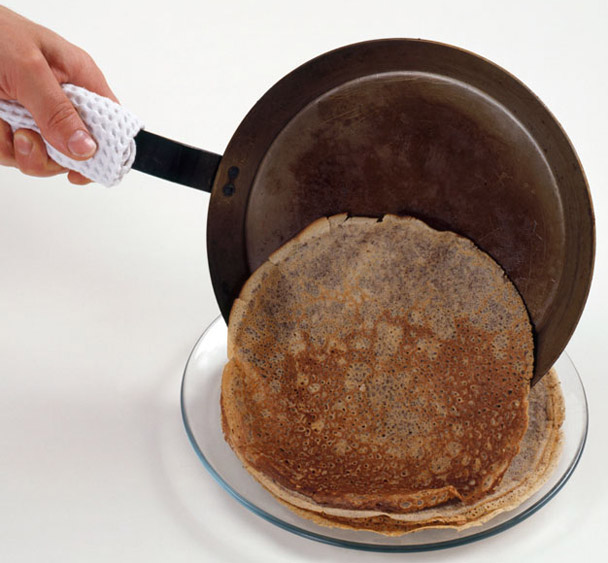
The mere mention of the word sends me straight back to Paris and my cooking–school days. It was a cold and damp January morning when I arrived in the city the weekend before school started. I was all alone, jet–lagged, culture–shocked, and my French was rusty, so I was way too intimidated to walk into a bistro—each one looking like a private men’s club with the crowd of guys at the bar. I kept walking the Left Bank streets, getting hungrier by the block, until I came upon a crêpe stand. And it only took a few Gallic hand signals before I had a hot butter–and–sugar crêpe warming my fingers.
But then I couldn’t leave the spot; the mechanics of the crêpe process were too mesmerizing. This was nothing like the wacky electric crêpe pan with the convex top my older brother got as a wedding present—no, this was the smartest, Frenchest fast–food concept ever. The crêpe master poured a ladleful of batter onto a solid flat circular metal burner—with flames underneath—and then deftly pushed it out around the plate with a T–shaped wooden dowel until he had a giant paper–thin pancake. Steam rose as the batter cooked, and when the top of the crêpe looked dry, the master loosened it with a long metal spatula, and flipped it over. At this point he spread it with one’s filling of choice and folded it in half, then precisely in thirds. A quick wrap in wax paper and it was in your hands in one minute flat.
The topping options in a French crêpe stand are straightforward basics, but oh–so good. You can go sweet, with Nutella, jam, or chocolate, or you can go savory with Brittany–style galettes—buckwheat crêpes folded around eggs or ham and cheese. (When I brought my husband and daughters to Paris 25 years later, it was crêpes and galettes that fueled us during the day.)
After a couple of weeks—and many crêpes—I met friends who turned me on to a custom crêpe–maker in the Jardin du Luxembourg who would melt the chocolate bars we brought him directly onto the crêpes. For months we were enamored of a particular variety of Lindt white chocolate bars—odd because I’ve never liked white chocolate—and we made frequent pilgrimages to his stand for an indulgent fix.
The crêpe lesson at cooking school came up early on. Is it any wonder? They’re easy, giving you big results for not much work, and I learned to prepare them in a black steel pan on top of the stove. Back in the States and a few years later in the Gourmet test kitchen, though, I quickly adopted the nonstick skillet.
Like French women and their artfully draped scarves, thin, tender crêpes have that je ne sais quoi magical ability to take something plain—whether it’s creamed chicken or butter and jam—and jazz it up with a snazzy wrap. The funny thing is, the crêpe itself couldn’t be more unassuming. It’s just a plain, super simple batter of milk, eggs, flour, and butter. (Add more flour and a little more milk and you’ve got your basic pancake or waffle batter.)
Despite their easy chic, crêpes and I parted ways when I married and had kids. Sunday mornings became an ironclad ritual of blueberry pancakes or waffles. Like so many other obsessed mothers, I tried to cram as many whole grains into my little darlings as possible, so I banished white flour to the back of the cupboard (I admit I kept it around for gravy) and started cooking with whole wheat, cornmeal, quinoa—you name it. Baked goods turned out rather heavy and dull, smacking of the worst kind of health food—until, that is, I discovered whole wheat pastry flour, ground from soft wheat, which has less protein and therefore less gluten than that used for all–purpose white flour. I also got turned on to spelt, which seems to be a little lighter still than whole wheat.
The more I cooked and baked with whole wheat pastry flour and spelt, the more I loved the results, and it wasn’t long before muffins, pancakes, and quick breads made with white flour tasted like library paste to me. By now I’m so used to the nutty flavor of whole grains that when I stopped at a crêpe stand in Greenwich Village last weekend with my college freshman daughter, and tasted the s’mores crêpe she’d been craving, I found it mediocre at best (and she agreed). I figured it was time to hook up with the crêpe again, and I began to play around with my own whole–grain version at home.
Well, I’m happy to report that whole wheat pastry flour and spelt work beautifully in crêpe batter. In fact, if you’re going to make a s’mores crêpe, a whole–grain batter is right in sync with the original graham cracker, which was created by Sylvester Graham, a 19th–century diet guru who advocated (among many other things) coarsely ground whole wheat flour—which came to be known as graham flour—as part of the vegetarian diet he preached. Poor fellow, he wouldn’t recognize today’s graham crackers!



 Pinterest
Pinterest


